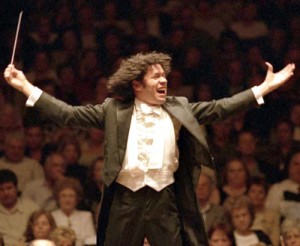
Last Thursday and Friday, Gustavo Dudamel gave tri-staters the opportunity to see him conduct for the first time since his inauguration as music director of the Los Angeles Philharmonic. At Avery Fisher Hall on Thursday, Dudamel and pianist Jean-Yves Thibaudet performed Leonard Bernstein’s Symphony No. 2 “The Age of Anxiety.” Times critic Anthony Tommasini called the performance “arresting” and said the work “if sometimes wild and brassy, was basically wonderful.” However, he was not as enamored with the LA rendition of Tchaikovsky’s Symphony No. 6 “Pathetique.”
Tommasini felt that technical faults in the performance hinted at under-preparation despite Dudamel’s emotive and carefully executed direction. While the lush, expressive lyricism lent itself to a poignant interpretation from the maestro, The NY Times thought the orchestra’s inability to deliver resulted in a performance that was “rough and unfocused.”
But on Friday, The Sound Post was able to see Dudamel continue his east coast performances with a similar program in Prudential Hall at the New Jersey Performing Arts Center. Dudamel and Thibaudet began the performance by repeating the same pristine execution of Bernstein’s 2nd Symphony “The Age of Anxiety” from the night before. Thibaudet’s sensitivity and thoughtfulness at the piano denied any personal anxieties and were matched by the orchestra’s care and attention throughout all six segments. After intermission, Dudamel returned with one of his specialties: Mahler’s Symphony No. 1 “Titan.”
Brimming with expressive and eloquent gesture, Dudamel stimulated the LA Phil into an energized performance of the Mahler after a brief warm up in the first movement. Perhaps an over-familiarity with the work made the opening seem too comfortable, but a playful emphasis of the dance-like elements in the second movement demanded the attention of both orchestra and audience and set the tone for rest of the piece.
As the orchestra drifted between the folk and klezmer duality of the third movement, Dudamel guided the music through each color of the opposing themes. Finally, the gloves came off, and the orchestra shined in the explosive fourth movement—its intimacy with Mahler was evident in the fiery, finger-and-embouchure-crushing passages that riddle the movement. Complete with a standing horn section in the finale, the performance exuded the majesty and prowess of the “Titan” and brought the crowd to its feet moments after Mahler’s powerful full-stop ending.
"News related to the modern world of classical music."





